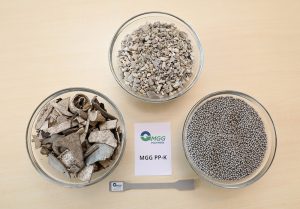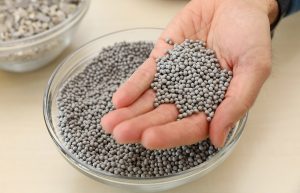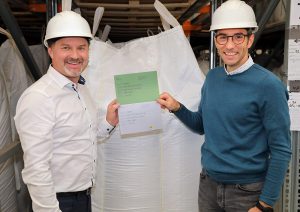MGG Polymers launches its activities in the recycling of plastics from large household appliances with the recovery of filled polypropylenes. Intensive research and application development in recent years have once again made the pioneers from Kematen an der Ybbs the technology leader in Europe. A further step has been taken to meet the growing demand for recycled plastics.
The starting position
In December 2019, the EU presented the „Green Deal“, a strategy to make the European economy more sustainable and also to reduce the root causes and effects of climate change. Within this, the „circular economy“ approach plays a key role, especially when it comes to plastics.
About one year ago MGG Polymers Managing Director Günther Höggerl reported in this context about the so-called „Plastics Strategy of the EU“. This contains declarations of intent (“Pledges”) from more than 100 companies/plastics users in Europe to reuse a huge volume of up to 10 million tons of recycled plastics per year in new products from 2025 onwards.

The recycling cycle: from shredded raw material through sorting to fresh granules.
The problem
At the moment the European plastics recycling industry is far away from being able to meet this demand. Current production capacities in the EU are around 4 million tons per year. This is far too little to achieve the ambitious goal mentioned above in this short period of time.
A solution.
Since 2019, MGG Polymers has been discussion the question of how to meet the expected increase in demand in the long term. A detailed approach was found soon: Namely, to align research and application development in a direction enabling the company to recycle plastics from large household appliances in addition to those from small electrical appliances. A strategic move that is obvious to MGG Polymers Managing Director Günther Höggerl: „We have a good reputation in the recycling of plastics from small electrical appliances over the past 15 years. However, we need to be more innovative in order to achieve the European targets. In our view, recovering plastics from large household appliances – the „white goods“ – is a logical next step.
Innovation
White goods mainly use polypropylenes with different fillers such as talc (PP-T), chalk (PP-K) or glass fiber (PP-GF). This means that in the sorting process, it is not enough to recognize and separate the PP as a polymer only, it is even necessary to be able to look “deeper” into the material. Of course, many steps were necessary from the first tests since 2019 to the current production status, as Innovation Manager Daniel Forstner knows best. He played a key role in developing the „filled PP“ research project and leading it to implementation. „The technological difficulty is primarily in separating the mixed raw material – a wild mixture of plastics, which also contains the polypropylene with its various fillers – by type. Our colleague Cornelia Wieser carried out intensive basic research in the MGG Metran laboratory and examined a huge number of samples in order to define the distinguishing features of PP-K, PP-T and PP-GF. After completing her work, she was even able to identify the material differences by the sound of the plastic.“
These analyzed sample pieces were an important part of the entire project, as they allowed the MGG team to decide whether existing equipment in the Müller Guttenbrunn Group would be suitable for separating the materials. Or, whether equipment needed to be reworked or it was necessary to contact machine manufacturers to develop completely new sorting solutions. The main challenge turned out to establish a proper sorting by those pieces of filled PP that contain only 10% filler or less and are also usually very dirty.
However, Höggerl and Forstner do not want to reveal how MGG Polymers has now managed to actually separate the individual fractions in detail: „What we can say is: The plastic parts must ultimately be sorted with the aid of sensor-based machinery. This makes the Müller-Guttenbrunn Group a pioneer once again, and we can be proud of that!“
The origin of the material

Sensor-supported separation of the three filled polypropylene types, allows pure granules to be produced.
In view of the raw material quantities available in Europ, the question arises where the necessary source material comes from. „The amount of large household appliances collected in Austria will not be sufficient in the medium and long term. In addition, the white goods are usually recycled together with other waste streams, e.g. end-of-life vehicles – but this makes subsequent plastic recycling uneconomical. Therefore, we source waste fractions from large household appliances from all over Europe. Waste management cannot be seen on a national basis only, but must be seen on a pan-european and cross-border basis“ explains Günther Höggerl.The amount of waste from large household appliances generated in Europe each year is a bit more than 3 million tons and thus at a similar level to that of small electrical appliances. Although the proportion of plastic in large appliances is lower than in small appliances, it can still be assumed to be around 400,000 tons per year.
While plastic recycling from small electrical appliances is now fairly established, the situation is still different for large household appliances. Throughout Europe, recycling activities for plastics from white goods are mostly limited to the removal of individual parts – e.g. the control panel of a washing machine – during manual dismantling. Many of the valuable plastics still end up in landfills, as this option for disposal is unfortunately still permitted in many EU countries.
The products
In addition to the existing product family of unfilled polypropylenes (PP), MGG Polymers now offers another family of PP with different fillers with the new sorting process. Of particular note are a polypropylene reinforced with approx. 30% talc and a polypropylene reinforced with approx. 35% calcium carbonate. The range is supplemented by a mineral-filled PP with a high glass fiber content. As with all other product families, the grades can be offered with different shades of gray.
Endurance tests carried out at well-known customers have already proven the suitability of the materials to be used in new large electrical appliances.
Another strong feature of the new product family is the outstanding „post consumer“ content, which is between 95% and 100%. The sorting process separates those polypropylenes that already contain the various fillers, so no separate addition of „new“ talc, calcium carbonate or glass fiber is necessary.

With some hundret tons of filled PP pellets in stock, MGG Polymers is marketable with this product.
The future
The next item on MGG-Polymers‘ agenda is to bring the market ready products into series use. The company has been working on corresponding projects together with well-known manufacturers of large household appliances since many months. „Of course, we also took advantage of the recent world’s largest plastics trade fair in Düsseldorf to report on our innovation. We had decided to place only a small information – still, the interest was already very high during the fair. So it’s good to know that we already have larger quantities of the new PP products in stock and are able to deliver immediately after clarification,“ Günther Höggerl proudly reports.
And where will the journey go? The managing director makes a clear statement on this: „MGG Polymers has always been – and will continue to be – committed to offering its customers high-quality recycled plastics. The key for the usability of our products in new electrical appliances is their properties and not so much which waste stream we gathered them. In the coming years, we will therefore place investments in all areas of the company so that we can obtain our products from different waste streams. This sounds easier than it is, but I´m positively looking forward to this task together with the entire team of the Müller Guttenbrunn Group. In any case, the preliminary work for the coming years is very encouraging“.
INFO BOX: Small electrical appliances versus large electrical appliances
Small electrical appliances are usually defined as electrical appliances up to a size of 50 x 50 x 50 cm – such as cell phones, printers, coffee machines or vacuum cleaners. Corresponding to that, larger appliances are categorized as large household appliances – e.g. washing machines, dryers, dishwashers. The main differences are mainly in the type of plastics being used. In small appliances, ABS (acrylonitrile-butadiene-styrene copolymer), PS (polystyrene) and PP (polypropylene) plastics are found predominantly, while PP with various fillers is mainly used in large household appliances.
Recycling targets are defined across Europe for different waste streams. The WEEE (Waste of electrical and electronical equipment) directive specifies a recycling rate of 55% for small electrical appliances, while for large electrical appliances this is 80%. In order to achieve this target, the recovery of plastics from large electrical appliances is essential.
